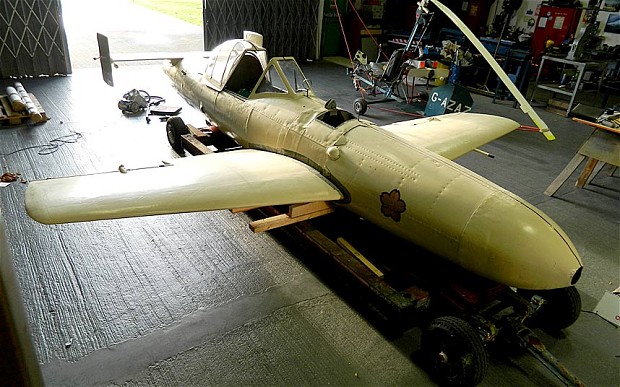
An exceedingly rare Kamikaze aircraft which was seized by the British at the end of the Second World War will be made available for public viewing for the first time.
The aircraft would have been lost to the world had it been flown by Japanese pilot on a successful suicide mission. It is one of just four of the aircraft which was salvaged and brought back to Britain from the Far East to be displayed in museums.
The condition and whereabouts of the other three are no longer known. The Kamikaze to be displayed, however, has been in safe-keeping for the last three decades at the Fleet Air Arm Museum near Yeovil, Somerset. The aircraft is a Yokosuka MXY7 Ohka 11.
From years of storage, the aircraft is now out in the open in preparation for a lengthy refurbishment. The museum plans to make the plane a part of the exhibition on the Pacific War in two years.
Part of the initial process of the renovation will require the removal of layers of paint which was applied to it after the war so that the original design will be seen.
Historically, the Kamikaze planes were used by the “Japs” during World War II as effective and lethal bombs because the pilots could direct and crash their planes towards their targets which include giant US aircraft carriers and ships. The term Kamikaze means divine wind in Japanese.


Japanese bombers, where the small Kamikaze planes were attached to the underside, would drop the suicidal planes from a height of 12,000 ft carrying a load of 1,200 kg of explosives attached to the front end.
The planes are built with three solid fuel rockets which blasted the crafts at speeds of 475 mph as the pilot directs it downward and towards the target enemy ship and maintains the speed until impact.
Upon the study of experts of the surviving plane, the cockpits were designed with very basic features. It was not built for the comfort of the suicidal pilot.
Jon Jefferies, a spokesman for the Fleet Air Arm Museum, said, “It is quite chilling to be sat in the cockpit looking out through the window through the ringed sight. It has a hard steel seat so it obviously wasn’t built for comfort.
“There is a grab handle fixed to the inner wall of the cockpit so you can imagine the poor pilot reaching out for it as the acceleration generated by the three rockets would have been incredible.
“It has been here for 30 years but we have got it out now as it will be refurbished and go on public display in time for our next exhibition about the war in the Pacific.”
A hatch is also placed on one side of the plane to open a compartment where the explosives are attached in the nose.
On the other side is an emblem of a cherry blossom, which also represents the name of the plane Ohka. The popular flower in Japan is a symbol of flowering and rebirth.
The project also undertook the translation of various insignia on the Ohka. Mr Jefferies said, “I was rather hoping the markings might reflect the attitude of the Japanese, like ‘For the glory of the Emperor.’
“However, the symbols read ‘outer plate, surface of the upper from rear sight. Foresight. Centre to height. 148.0mm’.”

